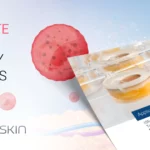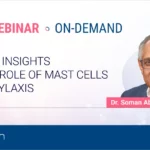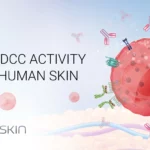Frequently asked questions
What are the different technologies developed by Genoskin?
- HypoSkin®, an ex vivo human skin model containing epidermis, dermis, and hypodermis, designed for studying subcutaneous and intradermal injections.
- NativeSkin®, a versatile epidermis-dermis model for topical and systemic studies. Variants include:
- Tape-Stripped NativeSkin® for skin barrier research
- WoundSkin® for wound healing, infection, and bacterial colonization
- HairSkin® derived from facial lift samples, with high follicle density
- FacialSkin derived from facial lift samples, with high sebaceous gland density
- InflammaSkin®, a T cell–driven, psoriasis-like model to test anti-psoriasis drugs (topical or injectable).
How do Genoskin's models have a similar structure to that of real human skin and show real human skin response?
Discover HypoSkin® | Download HypoSkin Validation White Paper
Are Genoskin models immunocompetent?
How does Genoskin preserve human skin viability? How long are the models viable?
- Surgical skin explants of controlled size are embedded in a solid gel matrix.
- A silicone ring preserves natural tension and biomechanical properties.
- Models are cultured in a chemically defined medium, which is replaced daily.
- The system maintains skin viability and functionality for up to 7 days.
How many models can you produce from a single donor?
- Abdominoplasty resections → up to 50 models per donor.
- Facial lift samples (used for HairSkin® or FacialSkin) → up to 15 models per donor.
How is donor-to-donor variability addressed in Genoskin models?
What are the use cases of Genoskin’s ex vivo human skin models?
- HypoSkin®: Injection site reaction (ISR) studies, local tolerance, vaccine candidate screening, bolus injections, medical device testing, dermal filler characterization.
- NativeSkin®: Topical absorption, irritation and safety testing, claim substantiation, toxicity assessment, wound healing, skin microbiome research.
- InflammaSkin®: Evaluation of anti-psoriasis therapies delivered topically or subcutaneously.
What type of mast cells do you provide?
- Provide a reliable solution to help you study human primary mast cells’ response to your compound or formula
- Display reliable degranulation in response to anti-IgE stimulation
- Support studies on drug efficacy, safety, and immunotoxicity
What are the use cases of Genoskin’s human mast cells?
- Toxicity assessment: Monitor mast cell degranulation as an early marker of drug-induced toxicity.
- Allergic reactions: Assess a compound’s potential to trigger mast cell activation and allergic responses.
- Drug efficacy: Evaluate the efficacy of a drug candidate in inducing immune activation through mast cell degranulation.
Are your models suitable for both topical and injectable formulations?
- Topical applications
- Intradermal and subcutaneous injections
- Transdermal application, insertion and infusion
- Systemic administration
Can Genoskin’s skin models be used for long-term studies?
What assays and analyses can be performed on Genoskin’s skin models?
- Viability assays (e.g., WST-8)
- Imaging: histology, immunofluorescence
- Multiplex cytokine profiling
- Transcriptomics: bulk and single-cell RNA sequencing
- Spatial biology using our proprietary MANTIS® platform
- Flow cytometry
This list is not exhaustive; we can adapt protocols and customize assays to meet your specific needs.
Contact us to discuss your project | Download validated NativeSkin® protocols
How do Genoskin’s models differ from animal models or reconstructed skin models?
- Compared to reconstructed skin: Our models preserve the full skin structure (epidermis, dermis, hypodermis), mature skin barrier, immune cells, and skin appendages (sweat glands, sebaceous glands, hair follicles). Genoskin models maintain the natural complexity and functionality of human skin, providing a more reliable platform for testing.
- Compared to animal models: Rodent and other animal skins differ in structure, barrier function, immune systems, and appendage distribution. Genoskin’s human skin models provide a directly translatable, human-relevant alternative for preclinical studies.
Do Genokin’s products allow standardized and reproducible experiments?
Do you offer models from different anatomical sites (e.g., abdominal, breast, back)?
Are your skin models available from donors of different ages or skin phototypes?
For reference:
- Most available donors are female (≈90%)
- Common age range: 30–50 years
- Most frequent phototypes: II–III
Requests for less common donor characteristics may extend the lead time.
Do skin models come in a standard size, or are there sizes to select from?
- NativeSkin®: 8 mm, 11 mm, 20 mm
- Tape-Stripped NativeSkin® & WoundSkin®: 11 mm, 20 mm
- HairSkin® & FacialSkin®: 6 mm, 8 mm
- HypoSkin®: 20 mm
What if I need a model that is not one of the standard sizes that Genoskin produces?
Do you have models from patients with specific conditions?
Does Genoskin guarantee the safety of its products? Are models tested for infectious agents before shipment?
- Negative testing for HIV-1/2 and Hepatitis B & C
- H&E staining results
- Clinical donor information
Do I need specific authorizations to receive ex vivo human skin models?
How do you ensure the quality of your human mast cells? What quality assurance do you provide with each shipment?
- Flow cytometry for CD117 and FcεR1 marker expression
- Anti-IgE–mediated degranulation assays (CD63 surface expression & β-hexosaminidase release)
- Viability testing
QC data is delivered with each order.
Do you store the sampled skin? Will I receive freshly sampled tissue, or is it stored after surgery?
What is the shelf life of the product? What is the recommended storage condition for the tissue?
- On delivery: add culture medium to the wells
- Place models in an incubator following the User Manual guidelines
Download the NativeSkin® User Manual | Download the HypoSkin® User Manual
Can I use the entire sample of your NativeSkin model after topical applications?
See detailed instructions in our User Manual
What type of equipment do I need in my lab when using the skin models or mast cells (e.g. biosafety cabinets, incubators)?
- Class II biological safety cabinet
- Incubator (37°C, 5% CO₂, 95% humidity)
- Water bath (37°C)
- Sterile micropipettors & pipette tips
For topical administration:
- Sterile forceps
- Positive displacement pipette (for semisolid materials)
- Mortar & pestle (for solid materials)
- Sharp spoon (for solid materials)
For subcutaneous/intradermal injections:
- 0.3 mL insulin syringe with 6–8 mm needle, 30G
- Sterile forceps
For mast cell culture:
- Class II biological safety cabinet
- Incubator (36–38°C, 4–6% CO₂, 95% humidity)
- Non-treated flasks or 6-well plates
Detailed instructions are provided in the User Manuals included with each kit.
Can Genoskin provide training for using the models for injections?
- In-person training: A Genoskin scientist can visit your lab, or your team can be trained at one of our facilities.
- Virtual consultations: Online sessions with a Genoskin scientist for tailored guidance and troubleshooting.
Both formats can be booked directly through our e-shop.
What kind of services does Genoskin provide?
Our services cover:
- Drug Development
- Injection site reaction (ISR) assessment
- Local tolerance studies
- Human primary mast cell testing
- Vaccine development (VaxSkin®)
- Anti-psoriasis drug testing (InflammaSkin®)
- Cosmetics & Consumer Goods
- Claim substantiation
- Barrier function studies
- Topical delivery & safety evaluation
- Medical Devices
- Injection, dermal filler, and implant safety testing
What is the workflow to perform a service with Genoskin?
- Introductory meeting: Virtual or in-person to discuss your project needs.
- Confidentiality agreement: A mutual CDA is signed to protect your data.
- Study plan: A Study Director drafts your plan while a Business Developer prepares a quote.
- Project initiation: Once approved and initiation payment is received, studies typically begin within 2 weeks.
- Execution & updates: Our team conducts the study and provides regular progress updates.
- Final deliverables: You receive a detailed report with results, conclusions, and recommendations. Raw data and study samples can also be provided upon request.
Where are the services performed?
- Toulouse, France
- Salem, Massachusetts, USA
The study location is chosen based on your location and the analyses required. Both facilities are staffed with technical experts and follow the same quality standards.
Can I get a personalized service offer for my study?
Do you provide protocol customization based on my study needs?
Can you help design experiments for regulatory submissions?
Can I send my own compounds for testing?
What is the deliverable of Genoskin’s services?
- Abstract
- Context & study objectives
- Materials & Methods
- Results (with figures/tables as relevant)
- Conclusions & recommendations
Optional:
- Intermediate reports (if agreed upon during study design)
- Raw data files provided upon request
Do you offer statistical analysis of results?
Can you perform comparative studies between multiple test articles?
How do you ensure confidentiality of my study and results?
- A mutual CDA is signed at the start of collaboration.
- If third-party involvement is required, this is clearly defined in the study plan and subject to your approval.
- All study data and results are archived in Genoskin’s secure system and shared only with the customer.
Are there any specific steps or requirements for first-time buyers? How do I order?
If you are based in the U.S. and belong to a tax-exempt organization, you’ll need to upload proof of tax exemption during sign-up. Our team will review your documentation and approve your account.
Once your account is approved, you can log in and place your order.
A representative will then collect your billing details. After this initial step, future orders will be faster and easier.
Can you ship your products everywhere? Can the products be shipped internationally while maintaining viability?
- Overnight delivery – U.S. and most European countries
- 72-hour delivery – Asia and other long-distance locations
This ensures that models remain viable and ready to use upon arrival.
Are there restrictions on purchasing human skin models in certain countries?
⚠️ Please check your local regulations for importing human biological specimens.
Is the culture medium included in the price, or should it be purchased separately? How much medium is provided?
If you need more, additional media can be purchased separately via our e-shop.
How long in advance should an order be placed?
How long does it take before I receive my order?
Can I track my order once it’s shipped?
How are Genoskin products packed?
- Skin models (NativeSkin®, HypoSkin®, etc.): shipped at controlled temperature.
- HistoSkin and fresh hypodermis: shipped at room temperature.
- FrozenSkin: shipped with up to 10 kg of dry ice.
- Human mast cells: shipped at room temperature, with culture medium delivered refrigerated.
What happens if the models arrive damaged or non-viable?
- Investigate the cause
- Provide a replacement production free of charge
For mast cells, please document the issue (photos + lot number) and contact support immediately. Our team will determine whether the issue stems from shipping, handling, or protocol deviations before providing a resolution.
Do you provide technical support after purchase?
- Troubleshooting for issues such as contamination or necrosis
- Access to validated protocols on our website
- Optional training:
- In-person training for injections in HypoSkin® models (bookable via the e-shop)
- Virtual consultations (bookable via the e-shop)
For human primary mast cells, extended technical support is available—please contact us for assistance.
What payment methods do you accept?
- Credit card payments at checkout
- Invoice-based payments (invoice issued upon delivery, 30-day payment terms)
Are bulk purchase discounts available?
Do you offer subscription or standing order options for recurring studies?
How does Genoskin obtain human skin tissue samples?
Do you work with tissue banks or hospitals directly?
Do all donors sign an informed consent form?
What are the typical donor characteristics (e.g., age, phototype, health status)?
- Age
- Gender
- Known skin conditions or diseases
- Current medications (e.g., corticosteroids, immunosuppressants, antibiotics)
Typical donor demographics:
- Gender: ~90% female
- Age: 30–50 years (≈60%)
- Phototype: II–III (≈90%)
That said, donors may be male or female, aged 18–90, and of any phototype.
Will I receive any donor information?
- Age
- Gender
- Skin type/phototype
- Anatomical site of the tissue
From what types of surgeries are the skin samples sourced?
- Abdominoplasties (≈60%)
- Circular abdominoplasties
- Thigh lifts
- Arm lifts
- Facelifts
- Eyelid surgery
How quickly after surgery are the skin samples processed?
What is the traceability process for skin samples?
- Rigorous hospital collection protocols
- Anonymized donor data (no identifying information is shared)
- Full documentation of sample handling from surgery to model production
What approvals and authorizations does Genoskin hold for skin sourcing?
- Informed donor consent for all cosmetic surgical procedures
- Donor approval aligned with the Declaration of Helsinki
- Authorization from the French Ministry of Research and Higher Education
- Oversight by Ethics Committees (CPP – Comité de Protection des Personnes)
- Legally binding Biological Sample Transfer Contracts with all partner hospitals and clinics
What ethical committees or institutional review boards (IRBs) oversee Genoskin’s work?
Does Genoskin follow international ethical guidelines (e.g., Declaration of Helsinki)?
How does Genoskin balance scientific research needs with donor privacy and rights?
- Informed consent: Every donor signs a consent form before undergoing elective surgery (e.g., abdominoplasty, brachioplasty, facelift). This form explains how their excised skin tissue may be used for research.
- Voluntary donation: Donors are free to decline donation without any impact on their surgery or treatment.
- Purpose transparency: Donors are informed that their tissue will contribute to the development of human skin models as alternatives to animal testing.
- Anonymization: All donor information is anonymized to ensure complete privacy.
In practice, most donors are pleased to contribute to advancing science by donating tissue that would otherwise be discarded.
How does using ex vivo human skin reduce reliance on animal models in research?
- Animal-component free (ACF) / Xeno-free (XF): No animal-derived materials are used.
- Designed to replace in vivo animal experiments for skin toxicity, irritation, safety, and efficacy testing.
- Able to bridge the gap between in vitro assays and human clinical trials by providing physiologically relevant human data.
This approach not only improves translational relevance but also actively reduces the need for animal testing in drug, vaccine, cosmetic, and medical device development.
In what ways are Genoskin’s solutions more ethical than animal testing?
- Using donated human skin tissue with informed consent, rather than live animals.
- Following strict international ethical regulations and donor privacy protections.
- Delivering human-relevant data that improves predictability and reduces reliance on animal experiments.
This ensures that product developers can advance research while respecting both human donor rights and animal welfare.
What certifications does Genoskin hold?
- Commitment and involvement of top management
- Strong customer focus
- A process-driven approach
- Continual improvement of systems and practices
How do you handle deviations or non-conformities in production?
If a deviation impacts a customer’s study or production, we will reproduce the affected models or repeat the impacted part of the study at no extra cost.
How does Genoskin ensure consistent quality across its models and services?
- Standardized protocols and SOPs across Production, Services, and R&D
- Regular verification and updates of procedures
- Cross-team training to ensure uniform application of quality standards
This ensures that every model and study meets the same high level of scientific rigor and reproducibility.
Do you have internal or external audits?
- External audits are conducted annually
- All processes are reviewed: sourcing/biobanking, production, services, R&D, sales, quality, etc.
- Audits follow a 3-year certification cycle (1 initial audit + 2 follow-up audits)
This dual system guarantees compliance, transparency, and continuous improvement.
Can data generated with Genoskin’s solutions be used for both U.S. and EU regulatory filings?
Are your models compliant with OECD testing guidelines?
How do Genoskin’s models fit within the FDA Modernization Act 3.0 recommendations?
- Validated, human-relevant alternatives to animal models
- Suitable for toxicity, safety, and efficacy studies of topicals, injectables, and medical devices
- Designed to improve human predictability and reduce species-specific discrepancies seen in animals
- Fully compatible with FDA guidelines for reproducibility, human relevance, and ethical standards
By adopting Genoskin’s models, pharma and biotech companies can accelerate their regulatory pathways, remain compliant with new U.S. regulations, and improve both scientific rigor and ethical practices.
How is pricing determined (per model, per batch, or per study)?
- Skin models: priced per model (depending on type and size)
- Human mast cells: priced per batch (1M, 2M, or 5M cells)
- Other products: pricing is clearly stated in our e-shop
- Studies: pricing is customized per study, based on:
- Number of models
- Treatments and readouts
- Data analysis and reporting
A Business Developer will provide a detailed quote for each study.
Do you provide quotes or cost estimates before starting a project?
- Products: generate and download your own quote directly in our e-shop.
- Studies: after discussing your project, you’ll receive a study plan with a detailed quote. The study only begins once the quote is approved and a purchase order is received.
How much does a skin model cost?
Is there a minimum order quantity?
Are shipping and handling costs included in the price?
- Packaging & handling: €/$100
- Shipping costs: depend on the destination region
What payment methods do you accept?
- Credit card payments
- Invoice-based payments with 30-day terms
Do you offer academic or bulk order discounts?
- Products: our prices are already competitive, so no general discounts are offered.
- Services: discounts may be available on a case-by-case basis.
Can pricing be adapted for long-term partnerships or subscription models?
What are your invoicing and payment terms?
- Payment due within 30 days of invoice date
- No offsets or deductions unless agreed in writing
- For services:
- 50% initiation payment required
- Study begins after receipt of payment, customer materials, and a signed study plan
- Invoices follow the payment schedule agreed in the accepted quote
How does Genoskin work with customers on study design and execution?
- Kick-off meeting: You meet with a Study Director to define your needs.
- Study plan & quote: A tailored plan is drafted; a Business Developer prepares the quote.
- Review & adjust: The plan and quote can be refined to fit your goals.
- Project initiation: Study starts within 2 weeks of receiving:
- 50% initiation payment
- Your test articles
- Signed study plan
- Updates: Regular progress updates are shared.
- Final deliverables: A comprehensive report is delivered, with optional follow-up calls to discuss results and next steps.
Do I need to sign a non-disclosure agreement (NDA) before starting a project?
What is your cancellation or rescheduling policy for studies or orders?
- Orders cannot be canceled once a Purchase Order has been accepted.
- Modifications are possible but require confirmation from Genoskin.
- The confirmation will be communicated in writing and will include any changes (price, date, service scope) before being applied.
How can I contact the Genoskin team?
What is the expected response time from your team?
Do you have regional representatives or local distributors?
- EMEA-APAC
- UK
- North America – Northeast, West, and Mid-Atlantic
We also work with local distributors in Japan and India.
Do you provide scientific or technical support for using your models?
- Troubleshooting: assistance for issues such as contamination or necrosis
- Validated protocols: available on our website
- Training options (bookable via our e-shop):
- In-person training for HypoSkin® injections
- Virtual consultations with our scientists
For human primary mast cells, extended technical support is available—please contact us for assistance.
Do you provide resources or documentation (e.g., protocols, user guides) with your models?
Do you provide training on how to use your skin models?
- In-person training: one of our scientists can visit your lab, or your team can train at our facilities.
- Virtual consultations: remote sessions with a Genoskin scientist for tailored guidance.
Both options can be booked directly through our e-shop.
Do you offer post-study consultations or data interpretation support?
- Review the results in detail
- Answer your scientific questions
- Discuss next steps or additional studies
Is customer support available in multiple languages?
Can I visit Genoskin’s facilities?
- Toulouse, France
- Salem, Massachusetts, USA
Please contact us in advance to arrange your visit.





